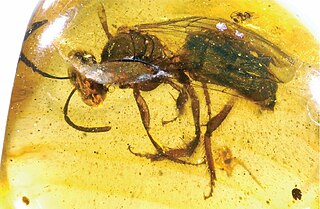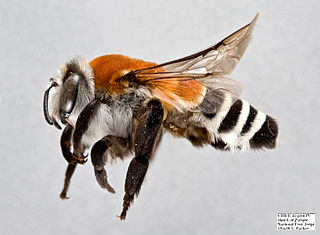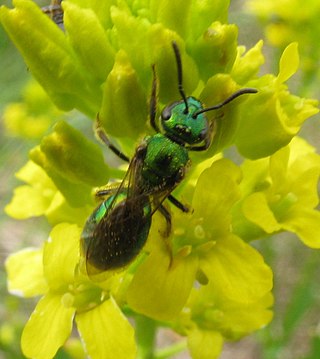
Carpenter bees are species in the genus Xylocopa of the subfamily Xylocopinae. The genus includes some 500 bees in 31 subgenera. The common name "carpenter bee" derives from their nesting behavior; nearly all species burrow into hard plant material such as dead wood or bamboo. The main exceptions are species in the subgenus Proxylocopa, which dig nesting tunnels in suitable soil.

Halictidae is the second-largest family of bees with nearly 4,500 species. They are commonly called sweat bees, as they are often attracted to perspiration. Halictid species are an extremely diverse group that can vary greatly in appearance. These bees occur all over the world and are found on every continent except Antarctica. Usually dark-colored and often metallic, halictids are found in various sizes, colors and patterns. Several species are all or partly green and a few are red, purple, or blue. A number of them have yellow markings, especially the males, which commonly have yellow faces, a pattern widespread among the various families of bees. The family is one of many with short tongues and is best distinguished by the arcuate basal vein found on the wing. Females in this family tend to be larger than the males. They are the group for which the term 'eusocial' was first coined by entomologist, Suzanne Batra.
Michael S. Engel, FLS, FRES is an American paleontologist and entomologist, notable for contributions to insect evolutionary biology and classification. In connection with his studies he has undertaken field expeditions in Central Asia, Asia Minor, the Levant, Arabia, eastern Africa, the high Arctic, and South and North America, and has published more than 925 papers in scientific journals.Some of Engel's research images were included in exhibitions on the aesthetic value of scientific imagery.

In biology, Lipotriches is a large genus of sweat bees in the family Halictidae, distributed widely throughout the Eastern Hemisphere though absent from Europe. There are nearly 200 species in 9 subgenera. They commonly have prominent bands of hair on the margins of the metasomal segments.
Neocorynura electra is an extinct species of sweat bee in the Halictidae genus Neocorynura.

Oligochlora is an extinct genus of sweat bee in the Halictidae subfamily Halictinae. The genus currently contains six species, all of which are known from the early Miocene Burdigalian stage Dominican amber deposits on the island of Hispaniola.

Nesagapostemon is an extinct monotypic genus of sweat bee in the Halictidae subfamily Halictinae. At present, it contains the single species Nesagapostemon moronei.
Eickwortapis is an extinct monotypic genus of sweat bee in the Halictidae subfamily Halictinae which contains the single species Eickwortapis dominicana.
Augochlora leptoloba is a species of sweat bee in the genus Augochlora and the extinct monotypic subgenus Electraugochlora.
Protosialis casca is an extinct species of alderfly in the Sialidae subfamily Sialinae. The species is solely known from the early Miocene, Burdigalian stage, Dominican amber deposits on the island of Hispaniola. Protosialis casca is one of only two known alderfly species present in the West Indies, the only other species is the living Protosialis bifasciata native to Cuba.
Halictus? savenyei is an extinct species of sweat bee possibly in the halictid genus Halictus. The species is solely known from the Early Eocene, Ypresian stage, Coldwater Beds, part of the Princeton Group, in the Quilchena area, Nicola Country, British Columbia, Canada.
Ischnomelissa rasmusseni is a Neotropic bee in the family Halictidae.

Caupolicana is a genus of bees in the family Colletidae, native to the Americas; most species are crepuscular in habit, visiting flowers only at dawn and/or dusk. There are over 50 known species, in 4 subgenera.

Sphecodes is a genus of cuckoo bees from the family Halictidae, the majority of which are black and red in colour and are colloquially known as blood bees. Sphecodes bees are kleptoparasitic on other bees, especially bees in the genera Lasioglossum, Halictus and Andrena. The adults consume nectar, but because they use other bees' provisions to feed their offspring they do not collect pollen.

Dialictus is a subgenus of sweat bees belonging to the genus Lasioglossum. Most of the members of this subgenus have a metallic appearance, while some are non-metallic. There are over 630 species worldwide. They are commonly found in the Northern Hemisphere and are found in abundance in North America. Members of this subgenus also have very diverse forms of social structure making them model organisms for studying the social behavior of bees.

Augochlorella is a genus in the bee family Halictidae, commonly called sweat bees. They display metallic coloration, ranging from reddish to gold to bluish green, as is typical for other genera in the tribe Augochlorini.

Dieunomia is a genus of sweat bees in the family Halictidae. There are about nine described species in Dieunomia.
Halictus hotoni, Hoton's metallic-furrow bee, is a species of sweat bee in the family Halictidae native to southern Africa and introduced to Australia. It was initially identified as the Emerald metallic-furrow bee It was described by Joseph Vachal in 1903.

Megalopta is a widespread neotropical genus of bees in the tribe Augochlorini in family Halictidae, known as the sweat bees. They are the largest of the five nocturnal genera in Augochlorini. Most have pale integumentary pigmentation, and all have large ocelli, most likely a feature of their nocturnal behavior. They live in tropical Central America and the entirety of South America. The subgenus Noctoraptor is cleptoparasitic. They are not known from the fossil record.
Neocorynura is a genus of bees belonging to the family Halictidae.










